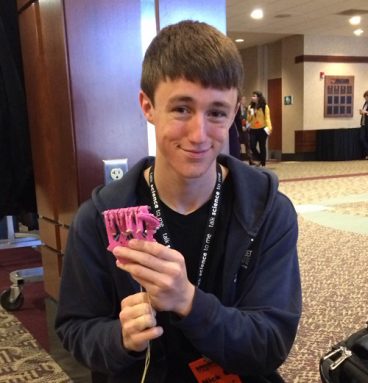A 3-D printer prints a better life
A high school student uses a 3-D printer to make a mechanical hand for a little girl in need
At first glance Nick Parker, 18, appears to be holding a weird pink plastic toy. About six inches high, the object has a square base and five prongs coming off at angles. The whole thing looks like it’s connected with a pile of string. But this is far more than pink plastic and wiring. This senior at Westmont High School in Campbell, Calif., is holding a handmade mechanical hand.
While Nick has no problem with pink, the hand is not for him. A 5-year-old girl in his community was born without a hand and Nick decided to offer his help. He is part of E-nable, a group using 3-D printers to fashion mechanical hands and fingers for those in need.
Nick has always been interested in making things. He started with home videos in middle school. “They were terrible,” he admits, “but then I got into the idea of special effects.” Nick played around with two-dimensional effects and computer generated imagery. Eventually, he says, “I realized I’d rather make things in real life.”
Nick hit on 3-D printing during his freshman year of high school. With guidance from a computer program, a 3-D printer lays down thin layers of plastic, paper, powder — even cells — to build a three-dimensional object. The teen describes it as “a hot glue gun waved around by a computer.” With different programs, the printer can produce any shape, depositing layer after layer. The end result could be as simple as a toy car or as elaborate as a designer dress or house.

And it wasn’t his last. Nick has since built two more, one for his high school robotics group and one for a local third-grade classroom. He’s used his own printer to make battery-powered helicopters and other objects. Now, he’s on to hands.
Recently, Nick joined E-nable. Along with its parent organization, Robohand, these groups are dedicated to making mechanical hands for people who may have been born without them, or who lost hands or fingers to accidents. E-nable has a Facebook group and Google + community that match people who need hands with makers and their 3-D printers. When Nick joined the community, he got a list of people requesting a hand. And it only took a glance over this list to see that one girl in need lived just 20 minutes away from him.
I met Nick in Raleigh, N.C., at the ScienceOnline Together meeting. He had brought a prototype prosthetic hand with him. Made from pink plastic and string, it has 12 printed parts that fit together with nuts and screws. The finger joints are connected with string. Those strings extend to the elbow, where they wrap around a pulley and attach to a cuff on the upper arm. Bending the elbow will close the hand; straightening the elbow will open it. All the parts together took about eight hours to print. “It’s very simple,” he says. “but it adds a lot of function.” For example, a child can use the hand to brush her hair or tie her shoes.
Nick says that E-nable is always looking for more people willing to help out. If you have access to a 3-D printer and are looking to make a difference, check out E-nable. You could end up changing someone’s life.
Power Words
3-D printer A machine that takes instructions from a computer program on where to lay down successive layers of some raw material to create a three-dimensional object.
prosthesis An artificial device that replaces a missing body part. A prosthetic limb, for example, replaces parts of an arm or leg. These replacement parts usually substitute for tissues missing due to injury, disease or birth defects.
prosthetic Adjective that refers to a prosthesis.
prototype A first or early model of some device that still needs to be perfected.







